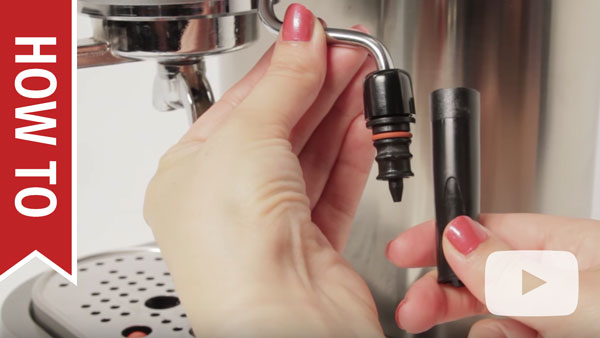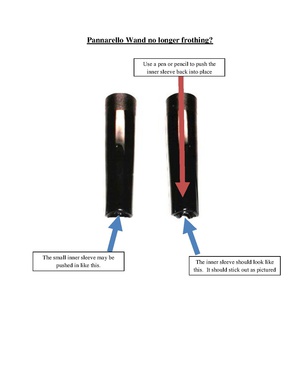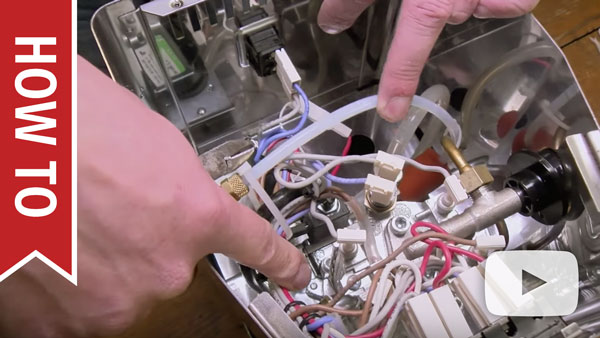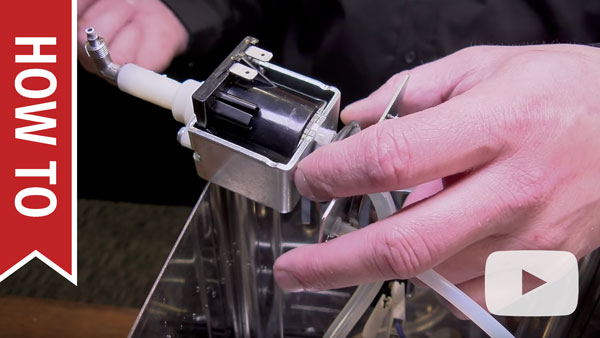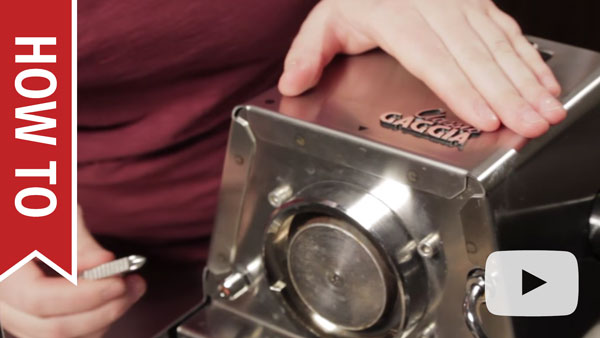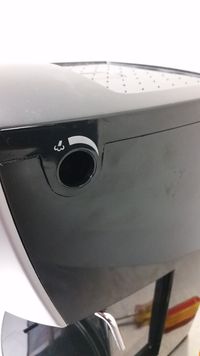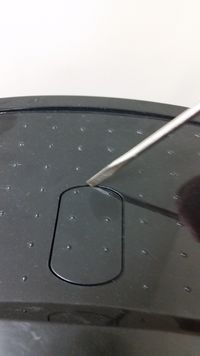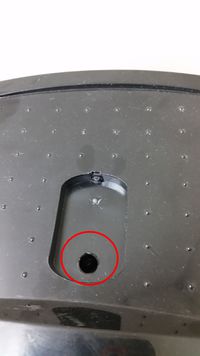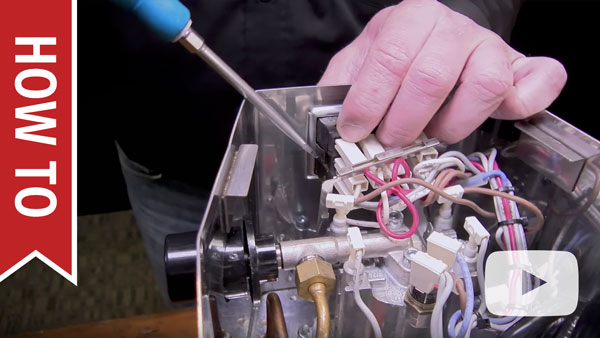Gaggia Evolution/troubleshooting
From Whole Latte Love Support Library
No Crema or Bad Tasting Shots
Typically, issues with crema or the flavor of the shot do not indicate a malfunction of the machine. Instead, this indicates that an adjustment needs to be made in the brewing process or that different beans need to be used.
The following articles review the different variables and offer solutions:
- Tamping The Correct Way and The Effects Of Tamping Pressure
- Grinding Coffee For Espresso
- It is important to use fresh beans, typically beans roasted within the past two weeks are best. Light and medium roasts are best for espresso brewing and richer crema. Storing beans properly is also important, more information can be found here.
If the behavior persists after reviewing these factors then the machine may need to be cleaned. Lack of cleaning can cause burned or bitter flavors, or create flow issues which can result in a weak shot. Navigate to the Cleaning & Maintenance icon above for more information.
Difficulty Frothing
As with brewing, frothing is highly dependent on technique. If the machine is producing steam then an adjustment to technique may need to be made. Frothing is very sensitive to technique, so there is a steep learning curve. The video below shows proper frothing technique:
There are also common frothing mistakes which are made that will result in poor or no froth. The video below identifies these mistakes and shows how to correct them:
This machine also utilizes a special nozzle attachment called a pannarello. The pannarello nozzle needs to be regularly cleaned and properly attached to the machine in order to function. The video below reviews how to attach the pannarello properly. When disassembling the pannarello please make sure all of the separate pieces shown in the video are present. The pannarello should be taken apart frequently and the separate parts should be soaked in some hot water to help remove any built-up milk residues.
Inside the tube of the pannarello nozzle there should be a plastic insert which must be present in order for this nozzle attachment to work. If this insert is missing or improperly inserted the machine will not be able to create froth. Please check the position of this insert as shown in this troubleshooting document:
Alternatively you can try frothing on the machine without the pannarello attachment. The naked wand can also produce a tight microfoam, and is preferred by some users. The major disadvantage of frothing with the naked wand is that it reduces the length of the steam wand by several inches.
Flow Issues
The first place to start with any flow issue is cleaning the machine. Before going through these steps please make sure the machine is cleaned according to the Cleaning & Maintenance section of this article.
No Steam From Wand
- Check the brew function on the machine and see if water is able to flow through the machine for this function.
- If the brew water is not flowing either refer to the No Flow At All section of this article
- If the brew water flows but is not hot refer to the On But Not Heating section of this article.
- Turn the hot water function on for the steam wand to test for flow.
- If nothing comes through refer to the Only Flow From Brew Head section of this article.
- If water does come through try setting the machine to steam mode again and testing for steam. Running the hot water function can help remove blockages in the steam wand assembly.
- Unplug the machine and remove the top to check for any loose or disconnected wires, and resecure these connections.
- If nothing else looks wrong then the steam thermostat has probably failed in will need to be replaced. Instructions for replacing the thermostat can be found here.
Only Flow From Steam Wand
Try these steps in the following order. Between each step test the machine for flow. If flow is restored to the machine do an immediate descale of the unit before returning to normal use.
- Test the flow of the machine without the portafilter attached. If the machine flows with the portafilter removed then one of the filter baskets is blocking the flow. Clean the baskets by soaking them in a solution of hot water and backflushing powder for 30 minutes, or boiling the baskets for 30 minutes.
- Make sure the grouphead is completely clean and free of debris. Be sure to completely disassemble and clean the grouphead according to the instructions here.
- Do a complete boiler clean and rebuild of the machine using the instructions here.
Only Flow From Brew Head
- Remove the pannarello nozzle attachment from the steam wand and test the flow using the hot water function. If flow is restored then the pannarello nozzle needs to be fully disassembled and cleaned and then properly reattached.
- If the flow is still blocked then there may be a blockage in the steam wand itself. Clean the wand by using a pipe brush that has synthetic or plastic bristles; metal bristles can damage the wand. Then soak the wand in a solution of hot water and backflushing powder for ten minutes. Test flow again.
No Flow At All
If the machine is not outputting any water follow the instructions below. Once flow is restored make sure to pull a full 8 oz. of water using the hot water function to ensure the machine is correctly primed.
- Check the water tank to make sure it is filled to the max line.
- Make sure the inlet lines are in place and not blocked by anything.
- Activate the hot water function on the machine. You should hear a vibration noise coming from the machine to indicate that the pump is activated.
- If you can't hear anything coming from the machine then there may be a loose or disconnected wire inside of the machine. Unplug the machine and open up the top to inspect the inside for any loose or disconnected wires, particularly at the pump or the front switch panel. Firmly secure any loose wires and test flow again using the hot water function.
- If you hear the machine vibrating then the pump is turning on. Unplug the machine and open the top to inspect the inlet line to make sure it isn't kinked or pinched. If the hose is kinked straighten it out and then plug the machine in again to test for flow.
- The pump of the machine may be vapor locked, requiring a force prime of the unit.
- To force prime this unit take a kitchen syringe, turkey baster, or priming pump and fill it with water.
- Insert the tip of it into the inlet line of the machine.
- Activate the hot water function of the machine. When you hear the pump kick on quickly force water with your priming tool.
- Immediately turn the machine off to prevent air from being drawn into the line.
- Repeat this process multiple times. After 3-4 manual primes you should start to see water spitting from the steam wand. Once this happens you can put the inlet line back into the tank and try to prime the machine normally by pulling 8 oz. of water through the machine using the hot water function.
5. If no water flows from the machine and the pump just hums, rather than making it's normal sound or a louder rattling sound, the pump most likely needs to be replaced. Instructions for replacing the pump can be found below and a replacement pump can be purchased here
Machine Is Leaking
Coffee Spraying From Portafilter
This machine utilizes pressurized baskets. If coffee is spraying from the spouts of your portafilter during brewing then one of the pressurized baskets is being used without the required 2-way pin in place. A pressurized basket can be identified by holding the basket it up to light; pressurized baskets will only have one hole that you can see through. The 2-way pin must be inserted into the portafilter below the basket when pressurized baskets are being used. Non-pressurized baskets, the ones that have a lot of holes you can see through if held to light, do not require the use of a 2-way pin.
Between Portafilter & Grouphead
If the machine is leaking from between the grouphead and the portafilter then the grouphead gasket is either pushed out of place and needs to be reinserted properly, or the gasket is worn out. Typically grouphead gaskets will wear out from 6 months to a year depending on how heavily the machine is used. Premature wear to this gasket can be caused by using excessive force when attaching the portafilter, or leaving the machine on for long periods of time without use. It is important to distinguish where the leaking is occurring. If the gasket is leaking from farther up in the machine and coming down around the grouphead then refer to the section of this article which discusses leaking from the top of the machine instead.
If the leaking is coming from between the portafilter and grouphead where you twist the handle on, then the gasket will need to be replaced. Instructions for replacing the gasket of this machine can be found in the video on the right and replacement gaskets are available for purchase here. You can try using the instructions to clean and reseat the current gasket. If that does not resolve the leak then the gasket will need to be replaced.
From Top Of Machine
A leak from the top (or head) of the machine typically indicates a loose connection or broken part inside the machine. If the leaking is coming from between the portafilter and the grouphead then refer to the section of this article which covers changing the group gasket. Otherwise follow these steps to identify the source of the leak. It may be necessary to run the machine with the top removed in order to identify the leak.
- Turn the machine off and unplug it.
- Open the top of the machine. Check for any loose hoses, broken hoses or hoses with pinhole leaks, or any other fittings that are leaking.
- To open the top first remove the steam knob by pulling it off. The machine will look like this once the knob is removed:
- Next you will need to remove the screw hole cover on the top of the machine. There is a small slit in the back of the cover where you can insert a flathead screwdriver and pry the cover out.
- Once the cover is removed you will be able to access the screw that holds the top cover on. It is located in a hole on the top of the machine.
- Once the screw is removed the top will simply lift straight up and off.
- If you find a loose hose reconnect it to the appropriate fitting.
- Hoses that are broken or have pinhole leaks will need to be replaced.
- Other loose fittings can typically be resecured by screwing the part down. Plumbers tape or a sealing compound may be necessary to provide a good seal.
- Check the pump connections to make they are secure.
- Examine the pump to see if there are any cracks in it. If the machine was exposed to subfreezing conditions without being properly drained it can cause the pump to crack. Replace the pump if it is cracked.
- Make sure both the inlet line and the outlet line on the pump are securely connected. Check the brass elbow connection on the pressure side of the pump. If there is leaking coming from this elbow joint then it will need to be resecured. Apply a foodsafe sealing compound to the threading of the elbow and screw it back into the pump. Let the compound cure for 24 hours and the leak should be gone.
- Examine the boiler assembly.
- If there is leaking coming from between the boiler and the grouphead there are two possible causes.
- If there is leaking all around the edge where these assemblies meet they are not sealing properly.
- First try tightening the eight allen screws that secure the boiler and grouphead together. There are four allen screws at the bottom of the boiler assembly inside the machine, and the other four bolts are located externally beneath the head of the machine.
- If it continues to leak then the o-ring that seals these two assemblies has slipped out of place or is worn out and needs to be replaced. Try unscrewing the boiler and the grouphead by removing the eight allen screws mentioned in the previous steps. Clean the o-ring off and reseat it and screw the boiler assembly back into place.
- If this does not resolve the leak then the o-ring is worn out and needs to be replaced. Replacement o-rings can be purchased here.
- If the leaking is mainly coming from the side of the boiler that faces the front of the machine then the boiler is probably cracked. This will happen if the machine is exposed to subfreezing temperatures without being drain properly, or the machine is dropped. The boiler will need to be replaced.
- If there is leaking all around the edge where these assemblies meet they are not sealing properly.
- If you find a crack anywhere else on the boiler then the machine was exposed to subfreezing temperatures without being drained properly or the machine was dropped. The boiler will need to be replaced.
- If there is leaking coming from between the boiler and the grouphead there are two possible causes.
From Bottom Of Machine
- Check the water tank and drip tray to make sure that are no cracks or breaks where water can escape. Make sure they are properly positioned on the machine.
- Ensure that the return line is sitting inside the water tank. If the tube is outside of the tank, or pushed up into the machine it will cause a leak. Position it so that it is sitting inside the water tank.
From Steam Wand
- If the wand is leaking from the end of the wand it means the steam valve is not fully closed.
- Try tightening the knob down firmly. Pressure from the boiler will leak through the wand if the steam valve is not securely closed.
- If it feels like the knob is spinning in place then the knob may be broken. Try removing the knob and manually turning the steam valve closed. An adjustable wrench or a pair of pliers can help with this. If this stops the leak then the steam knob will need to be replaced.
- Descale the machine according to the instructions in the Cleaning & Maintenance section of this article. Scale buildup inside of the steam valve will prevent the valve from closing fully and can cause permanent damage to the valve. After the machine has been descaled run 4-6 tanks of water through the wand using the machine's hot water function to ensure any debris or scale in the valve is fully removed.
- If the leaking persists then the steam valve will need to be replaced.
- If the wand is leaking from where it connects to the machine then the wand is not sealing properly to the steam valve assembly.
- Make sure the wand is securely screwed in. At the top of the wand is a hex shaped stainless steel threaded fitting which screws into a corresponding brass fitting that is part of the steam valve assembly. Use an open ended wrench or adjustable wrench to make sure these two parts are firmly screwed together.
- If tightening the wand onto the steam valve assembly does not resolve the leaking issue then the o-ring that goes between these parts may be dirty, damaged, or out of place. Unscrew the assemblies and inspect the o-ring. Clean the o-ring off, reseat it around the threaded end of the wand, and screw the wand back into the machine. If the leaking persists this o-ring will need to be replaced.
Machine Not Heating Or Powering On
No Power
- Make sure the machine is plugged into an appropriate power source.
- Do not use the machine on a surge protect. This machine has a high power draw, more than a typical kitchen appliance such as a refrigerator or a microwave. Surge protectors are typically not rated to handle the amperage this machine requires.
- Try using the machine on a different outlet, and make sure the machine is the only appliance plugged into that outlet.
- The outlet has been exposed to moisture, dust, or debris, which is causing the outlet not to ground properly. This will result in a current fluctuation and the GFI will trip. If the GFI outlet is located on the outside wall of a house moisture caused by high humidity, rain, or other weather can also contribute to these fluctuations.
- Try testing another appliance on the same outlet.
- The power cord of the machine can be removed from the back of the machine as well as from the outlet. Check to make sure the cord is firmly secured in its corresponding socket on the machine. Check the cord for any damage. If the cord is secure and the machine is still not powering on then it may be the cord itself causing the issue. The cord is a standard computer power cord. Swap the cord out with another 3-prong computer power cord and see if the machine powers on. If it does then the machine needs a new power cord.
- Turn the power button off and unplug the machine. Remove the top of the machine.Check the machine for any loose, disconnected, or burned wires. Check the power switch terminals in particular.
- If the machine recently had a leak, had water spilled on it, or any other exposure to moisture then the machine may be shorting out. Try letting the machine sit unplugged for 48 hours to make sure there isn't a short caused by moisture.
- If none of the above troubleshooting resolved the issue, the thermal fuse may need to be replaced. A replacement thermal fuse can be purchased here
Brew Not Heating
- Check to make sure the machine is set to heat for the brew function.
- Give the machine sufficient time to heat up. It can take up ten minutes for this machine to be sufficiently heated for brewing. Make sure the portafilter is attached during heating.
- Make sure the brew indicator light has come on to indicate the machine is heated.
- While the water in the boiler may have heated to the correct temperature within minutes the grouphead may still be cold. If the grouphead is still cold then the temperature of the brew water will be drastically reduced once the water exits the boiler and comes into contact with other cooler components. This is why it is important to give the machine at least ten minutes to fully heat.
- If the water coming from the brew head is completely cold then the brew thermostat will need to be replaced. Thermostat replacement instructions can be found below and replacement brew thermostats can be purchased here.
Steam Not Heating
- First make sure that there isn't any sort of flow issue by looking at the section of this article that discusses steam wand blockages.
- Make sure the machine is set to steam mode, and that the indicator light has come on to indicate that the machine is heated for steam.
- It is normal to have water come through the steam function for the first 5-10 seconds of steaming. This happens because the hot steam condenses back into water after it leave the boiler and come into contact with the room temperature steam valve and wand assemblies. For this reason you should do a process called purging.
- To purge the steam wand place an empty cup under the steam wand and turn the steam knob to the open position.
- Let the steam come through for 5-10 seconds, until there is significantly less water and a strong jet of steam.
- Close the knob, and begin your normal frothing process.
- If the steam ready light comes on immediately when selected and the machine does not heat up to steam temperature, the steam thermostat will need to be replaced. Thermostat replacement instructions can be found below and replacement steam thermostats can be purchased here.
On But Not Heating
- Unplug the machine and open the top. Check the machine for any loose or disconnected wires. Check the steam and brew thermostats specifically to make sure the leads to them are securely connected.
- This issue typically occurs because the machine is left on for an extended time without use, or the machine experienced a power surge. Home units like this should only be left on for a maximum of 45 minutes without use. The machine should be turned off if it is not going to be used within that time.
Pannarello Nozzle Not Staying Attached
If the pannarello nozzle attachment is not staying on the machine, or it keeps blowing off during steaming, then it is either not attached properly or is plugged with milk residues and needs to be cleaned. Please refer to the cleaning and attachment instructions covered in the frothing issues section of this article.
Portafilter Handle Not Fitting On Machine
- On new machines the portafilter will not fit perpendicular to the machine. This is because the grouphead gasket requires time to wear in before this can happen. As long as you can get the portafilter hand tight onto the machine and brew without leaking then the machine is operating properly. Do not use excessive force when attaching the portafilter or it can damage or break the grouphead gasket.
- Too much coffee may be dosed into the portafilter. If there is too much coffee in the portafilter is can press into the shower screen and prevent the portafilter from attaching properly. Reduce the amount of coffee in the portafilter or test the machine with an empty portafilter. If the portafilter attaches properly then the filter basket was simply overdosed.
- Check the filter baskets for dings, dents, or any sort of warping. A filter basket that is malformed can prevent the portafilter from attaching. Try attaching the portafilter with the basket removed, or with a different basket to see if it fits on correctly.
- The group gasket has slipped out of place or needs replacing. Please refer to the section of this article which discusses gasket issues for instructions on how to test the gasket or replace it.
- The grouphead may be damaged. If the machine was dropped or the grouphead was struck hard, then it can damage the grouphead. The grouphead would need to be replaced. This is not a normal occurrence and only happens if the machine has been mishandled.
Machine Is Making Loud Noises
- If the noises are occurring specifically during steaming, and it sounds like a loud pinging, then the sleeve insert on the pannarello assembly is not in the proper position.
- If there is a knocking or metallic banging sound while the pump is activated then the pump is probably off of its mounting. Open the top of the machine and resecure the pump to its mounting.
Too Much Steam/Milk Boiling
If you think your wand is producing too much steam, or your milk looks like it is boiling, then you may need to make an adjustment to your frothing technique. Boiling milk, or milk that is getting to hot before frothing is completed is an indication that incorrect frothing technique is being used. Review the section of this article that addresses frothing difficulties for more information.
If you have tried adjusting your technique and the wand still appears to be producing too much steam, then a steam test should be completed. Follow these instructions to perform a steam test.
If the machine is within the specified steam test range, then the machine is producing the correct amount of steam and an adjustment to frothing technique is necessary. Using a carafe that is chilled in a freezer before frothing is helpful for keeping the milk cooler for longer, allowing for more time to froth before the milk begins to scald.
Replacing the Portafilter Handle
If you need to replace your portafilter handle, instructions can be found here



